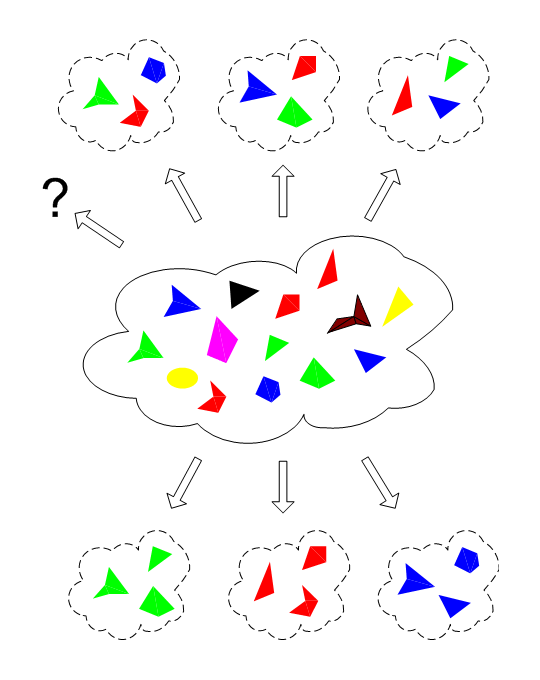|
Abstraction ladder, part 1 -
move over the elements for explanations - to part 2

The world of reality
For triangles one may substitute cows, for quadrangles horses, etcetera. The
various shapes and colors of the triangles represent the various individual
traits of every cow, or horse, etcetera.
Reality itself already groups many individual objects into collections having
common traits, as is denoted by a term like "cows'', and most aptly demonstrated
by the existence of a "herd": in our perception it exists of many similar things
(though not in those of the cows, of course).
But most groupings are hidden to our eyes, or to our direct perceptions. The
discovery of these hidden groupings is the subject of science.
Two examples of groupings have been given below and above.
Please note that in choosing a symbolic representation of objects from reality,
none of the at this point common choices of circles and squares have been used.
This is done on purpose, because circles and squares are ideals that do not
occur in reality. Houses have walls that are approximately perpendicular
to the floor, and never exactly perpendicular.
In this context circles and squares are used to denote constructions of the
mind, that can have ideal properties.
Aggregate 1 of objects from reality
Method: classification by color.
Color: green
Aggregate 1 of objects from reality
Method: classification by color.
Color: red
Aggregate 1 of objects from reality
Method: classification by color.
Color: blue
Aggregate 2 of objects from reality
Method: classification by the number of corners or sides
Number: five
Aggregate 2 of objects from reality
Method: classification by the number of corners or sides
Number: four
Aggregate 2 of objects from reality
Method: classification by the number of corners or sides
Number: three
Other aggregates of objects from reality
Method: As yet unknown.
The first big problem facing science is to find aggregates that are useful for
further investigation and classification. The classification by color has been
proven not to be very useful, the best known application being probably the rule that "red signifies danger".
The classification by the number of corners did prove to be useful in
mathematics, as will be shown in the next figure. In the real world example of
cows and horses this stands for the classification by species. Its usefulness
lies in the fact that it was the basis for the idea of the genetic origin of the
diversity found in the collection of species (as found by Mendel and his
successors).
Determine a grouping of objects taken from reality
Method: Obviousness, eexperience, intuition, or the best guess.
Most of the presently known groups i.e. abstractions taken from reality, are based upon obviousness,
like "cows", "horses", etcetera. This is because nature itself operates using these groups,
also known as "species". Etcetera.
The human mind can make up abstractions for itself, which may or may not be as efficient
as those of nature are. Predictions about their effectivity are difficult. The examples given in this
geometrical model are those of grouping by color and of grouping by number of edges.
The second turns out to be more effective than the first,
as far as the capacity of building even more abstractions is concerned.
More details about the process of constructing natural groupings and abstractions
is given here  .
This takes the process a step further back into reality by involving neurology, and is almost indispensible
for further unerstanding of the workings of the human mind. .
This takes the process a step further back into reality by involving neurology, and is almost indispensible
for further unerstanding of the workings of the human mind.
Determine a grouping of objects taken from reality
Method: Obviousness, eexperience, intuition, or the best guess.
Most of the presently known groups i.e. abstractions taken from reality, are based upon obviousness,
like "cows", "horses", etcetera. This is because nature itself operates using these groups,
also known as "species". Etcetera.
The human mind can make up abstractions for itself, which may or may not be as efficient
as those of nature are. Predictions about their effectivity are difficult. The examples given in this
geometrical model are those of grouping by color and of grouping by number of edges.
The second turns out to be more effective than the first,
as far as the capacity of building even more abstractions is concerned.
More details about the process of constructing natural groupings and abstractions
is given here  .
This takes the process a step further back into reality by involving neurology, and is almost indispensible
for further unerstanding of the workings of the human mind. .
This takes the process a step further back into reality by involving neurology, and is almost indispensible
for further unerstanding of the workings of the human mind.

|

